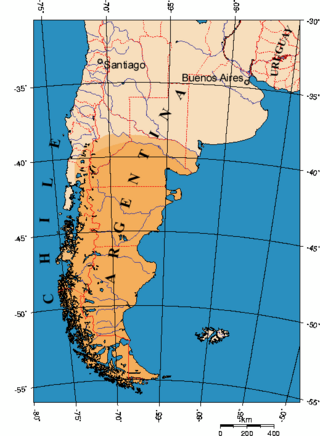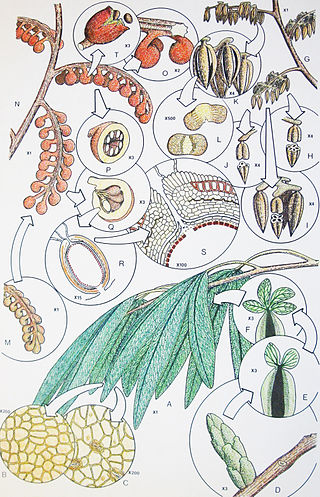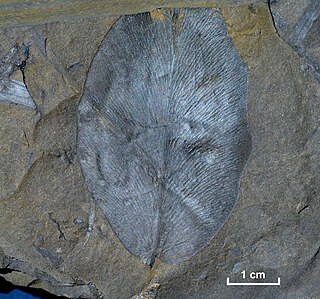
Patagonia is a geographical region that encompasses the southern end of South America, governed by Argentina and Chile. The region comprises the southern section of the Andes Mountains with lakes, fjords, temperate rainforests, and glaciers in the west and deserts, tablelands, and steppes to the east. Patagonia is bounded by the Pacific Ocean on the west, the Atlantic Ocean to the east, and many bodies of water that connect them, such as the Strait of Magellan, the Beagle Channel, and the Drake Passage to the south.
Volkheimeria is an extinct genus of sauropod dinosaurs that lived in what is now Argentina during the Early Jurassic, 178–179 million years ago. Its type and only species is Volkheimeria chubutensis.

Tehuelchesaurus is a genus of dinosaur. It is named in honor of the Tehuelche people, native to the Argentinian province of Chubut, where it was first found.
The Cerro Carnerero Formation is a geological formation of the Golfo San Jorge Basin in Chubut Province, Patagonia, Argentina.

The Caytoniales are an extinct order of seed plants known from fossils collected throughout the Mesozoic Era, around 252 to 66 million years ago. They are regarded as seed ferns because they are seed-bearing plants with fern-like leaves. Although at one time considered angiosperms because of their berry-like cupules, that hypothesis was later disproven. Nevertheless, some authorities consider them likely ancestors or close relatives of angiosperms. The origin of angiosperms remains unclear, and they cannot be linked with any known seed plants groups with certainty.

Caytonia is an extinct genus of seed ferns.

Sagenopteris is a genus of extinct seed ferns from the Triassic to late Early Cretaceous.
Caytonanthus is an extinct genus of seed ferns.
Luisiella is an extinct genus of prehistoric bony fish that lived during the Kimmeridgian stage of the Late Jurassic epoch. Fossils of the genus have been found in either the Cañadón Calcáreo Formation or Cañadón Asfalto Formation in Chubut Province, Argentina.
Henosferus is an extinct genus of australosphenidan mammal from Lower Jurassic of Argentina. The only recorded species, Henosferus molus, was found in the Cañadón Asfalto Formation of the Cañadón Asfalto Basin in Chubut Province, Patagonia.

The Cañadón Asfalto Formation is a geological formation from the Lower Jurassic, with doubtful layers of Late Jurassic age previously referred to it. The Cañadón Asfalto Formation is located in the Cañadón Asfalto Basin, a rift basin in the Chubut Province of northwestern Patagonia, southern Argentina. The basin started forming in the earliest Jurassic.

Leonerasaurus is a basal genus of sauropodomorph dinosaur. Currently, there is only one species known, named L. taquetrensis by Diego Pol, Alberto Garrido and Ignacio A. Cerda in 2011. The fossil, an incomplete subadult individual, was found in the Las Leoneras Formation in Argentina. This formation is probably Early Jurassic in age. Leonerasaurus was a small non-sauropod sauropodomorph, showing an unusual combination of basal and derived characters. This indicates that the evolution of early sauropodomorphs witnessed a great degree of convergent evolution.

Allkaruen is a genus of "rhamphorhynchoid" pterosaur from the Early Jurassic Cañadon Asfalto Formation in Argentina. It contains a single species, Allkaruen koi.

Sagenopteris williamsii is an extinct pteridosperm that is known from the late Jurassic and Early Cretaceous strata of the western interior of North America. It was first described as Chiropteris williamsii by J.S. Newberry in 1891, based on specimens from the Great Falls coal field in Montana. In 1956, it was referred to Sagenopteris by W.A. Bell based on additional specimens from western Canada.
Pandoravenator is a genus of basal tetanuran theropod dinosaur from the Late Jurassic of central Patagonia. Fossils in the form of a fragmentally preserved postcranial skeleton of this dinosaur were discovered and scientifically described in 2017 by paleontologists Oliver Rauhut and Diego Pol.

The Cañadón Calcáreo Formation is an Oxfordian to Kimmeridgian-aged geologic formation, from the Cañadón Asfalto Basin in Chubut Province, Argentina, a rift basin that started forming since the earliest Jurassic. It was formerly thought to date into the Cretaceous, but the age has been revised with Uranium–lead dating as likely being solely Late Jurassic in age.
The Cañadón Asfalto Basin is an irregularly shaped sedimentary basin located in north-central Patagonia, Argentina. The basin stretches from and partly covers the North Patagonian Massif in the north, a high forming the boundary of the basin with the Neuquén Basin in the northwest, to the Cotricó High in the south, separating the basin from the Golfo San Jorge Basin. It is located in the southern part of Río Negro Province and northern part of Chubut Province. The eastern boundary of the basin is the North Patagonian Massif separating it from the offshore Valdés Basin and it is bound in the west by the Patagonian Andes, separating it from the small Ñirihuau Basin.

The Lefipán Formation is a Maastrichtian to Danian, straddling the Cretaceous-Paleogene boundary, geologic formation of the Cañadón Asfalto Basin in Chubut Province, Patagonia, Argentina. The up to 380 metres (1,250 ft) thick stratigraphic unit comprises mudstones, sandstones, siltstones and conglomerates, sourced from the North Patagonian Massif and deposited in a deltaic to shallow marine environment with a strong tidal influence. The basin that in those times was connected to the widening South Atlantic Ocean with a seaway connection to the Austral Basin and possibly with the Pacific Ocean.
Los Adobes Formation is an Early Cretaceous (Aptian) geologic formation in Chubut Province, in the Cañadón Asfalto Basin of central Patagonia, Argentina. The formation belongs to the Chubut Group and represents the Early Cretaceous K1 megasequence in the basin, unconformably overlying the Late Jurassic Cañadón Calcáreo Formation and is overlain by the Albian Cerro Barcino Formation.
The Cañadón Asfalto Formation is a geological formation which dates to the Toarcian age of the Early Jurassic period of Argentina. The rocks of the formation preserve a diverse biota, including plants, dinosaurs, invertebrates, mammals and pterosaurs, among others. The formation is divided into two members: the lower Las Chacritas Member, and the overlying Puesto Almada member, though the latter has also been assigned to the overlying Cañadón Calcáreo Formation by some authors. The members are typically composed of fluvial-lacustrine deposits consisting of sandstones and shales, with a limestone carbonate evaporitic sequence also being present in the lower of the two.










